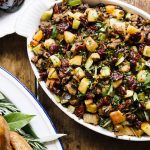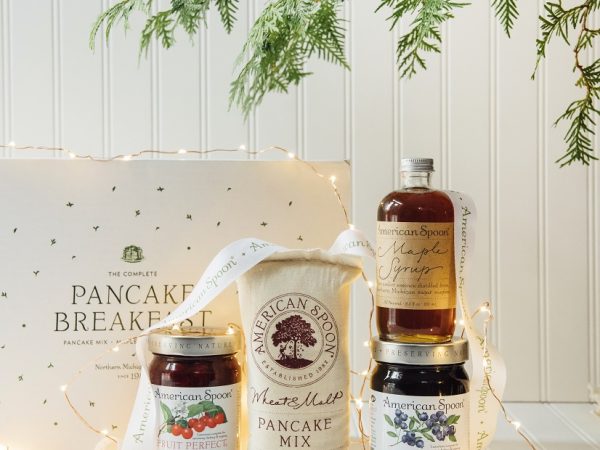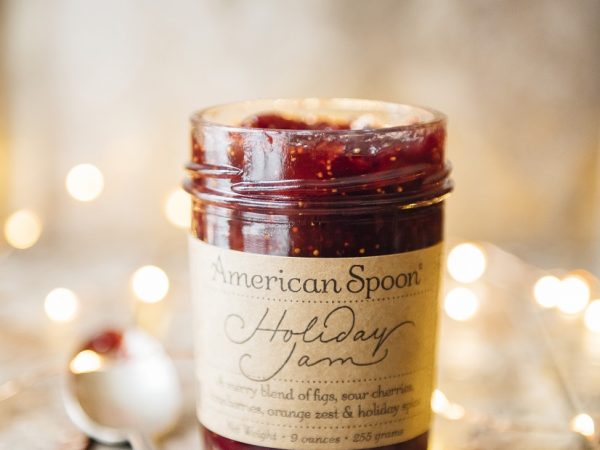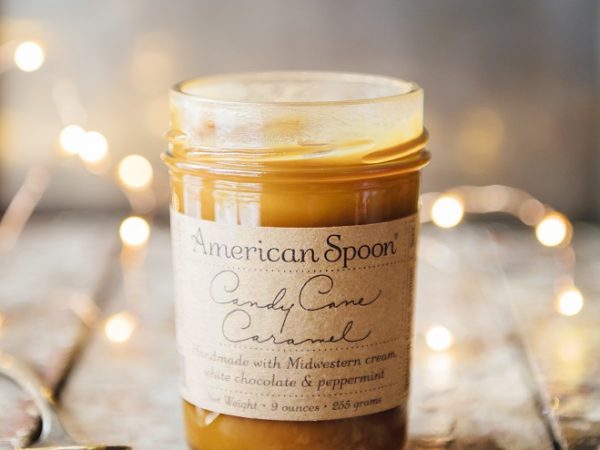
American Spoon: Conserving the fruits and vegetables of the season
Today — just in time for all the holiday cooking and eating that’s about to get underway — we begin a monthly series on Great Lakes Now called “The Foods of the Great Lakes.”
We will bring you tasty recipes – and stories with them about the people and companies that celebrate the bounty of the Great Lakes, where there is no shortage of culinary greatness: the wild rice of Minnesota; Lake Superior whitefish, Lake Erie Walleye, fruits and vegetables from orchards and farms throughout the basin , and the local beer and wine that flows from Kalamazoo to Milwaukee and Duluth to Toronto.
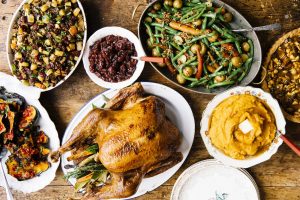
Holiday Entertaining, Photo by American Spoon
Last year, we posted a story “Eating the Great Lakes: The Decolonizing Diet,” about a Native American diet that inspired many of you to try cooking mostly local foods for your Thanksgiving meal.
We hope this series will inspire you to seek out Great Lakes Foods, not only over the holidays but every day.
And of course, recipes are part of the deal. (See my favorite Great Lakes Turkey Stuffing below.)
Our first story in this series is about American Spoon, a company based in Northern Michigan that has succeeded by drying and conserving the fruits and vegetables of the Great Lakes region.
We interviewed the founder of American Spoon, Justin Rashid. Here’s an edited transcript of that conversation:
![]() Great Lakes Now: American Spoon is a family affair. Tell us what your Petoskey, Mich.-based company does and how it began.
Great Lakes Now: American Spoon is a family affair. Tell us what your Petoskey, Mich.-based company does and how it began.
 Justin Rashid: When our mercifully brief acting careers ended in New York, my wife, Kate, and I moved back here to the place where I had always been the happiest, Northern Michigan. American Spoon could not have happened anywhere else. Petoskey is located at the northern end of a remarkable microclimate, a narrow ribbon of rolling, loamy land that hugs the Lake Michigan shore. It benefits from the Lake Effect and is ideal for growing cherries, apples, peaches, pears, blueberries, strawberries, grapes and many other fruits. The fields and forests surrounding Petoskey provide our wildflower honey, maple syrup, and an abundance of wild berries. Nearby farms now grow many of our vegetables as well. American Spoon grew out of a 40-year love affair with this special place.
Justin Rashid: When our mercifully brief acting careers ended in New York, my wife, Kate, and I moved back here to the place where I had always been the happiest, Northern Michigan. American Spoon could not have happened anywhere else. Petoskey is located at the northern end of a remarkable microclimate, a narrow ribbon of rolling, loamy land that hugs the Lake Michigan shore. It benefits from the Lake Effect and is ideal for growing cherries, apples, peaches, pears, blueberries, strawberries, grapes and many other fruits. The fields and forests surrounding Petoskey provide our wildflower honey, maple syrup, and an abundance of wild berries. Nearby farms now grow many of our vegetables as well. American Spoon grew out of a 40-year love affair with this special place.
Our company began in 1982 when my relationship as a forager and purveyor of Northern Michigan specialties supplying Larry Forgione, an innovative New York chef, evolved into the two of us co-founding American Spoon Foods, with the mission of making the best fruit preserves in America from Michigan fruits. Larry provided the first recipes, and I found the best fruits and growers and established the production facility. When we started, American Spoon made just a few flavors of preserves, and the company has now grown to a line of nearly 100 products, some of which are only available seasonally. My son, Noah, is now largely responsible for leading the company, and my grandchildren, Milo and Nina, love to pop in a few times a week to see what’s cooking or to help peel peaches or just to taste things.
![]() Explain some of the ways you have forged relationships with growers, foragers, hunters and gatherers across the Great Lakes.
Explain some of the ways you have forged relationships with growers, foragers, hunters and gatherers across the Great Lakes.
 These are simply long-term relationships built on mutual trust over many years. In the case of our fruit farmers, American Spoon agrees that if the grower will continue to cultivate a particular variety of strawberry, apricot, peach or pear, then American Spoon will promise to buy that fruit at a price that is significantly higher than large processors will pay. With foragers, we simply make a commitment to buy whatever the pickers can harvest and to pay a price that makes it worth the effort. In this way, we have established relationships with foragers who continually supply thousands of pounds of wild elderberries, wild blueberries, wild blackberries and wild thimbleberries. The authentically rare flavors of these hand-picked wild fruits are simply amazing.
These are simply long-term relationships built on mutual trust over many years. In the case of our fruit farmers, American Spoon agrees that if the grower will continue to cultivate a particular variety of strawberry, apricot, peach or pear, then American Spoon will promise to buy that fruit at a price that is significantly higher than large processors will pay. With foragers, we simply make a commitment to buy whatever the pickers can harvest and to pay a price that makes it worth the effort. In this way, we have established relationships with foragers who continually supply thousands of pounds of wild elderberries, wild blueberries, wild blackberries and wild thimbleberries. The authentically rare flavors of these hand-picked wild fruits are simply amazing.
![]() We hear that fewer workers are available for the harvest, not only in the Great Lakes but across the nation. Is this affecting your business?
We hear that fewer workers are available for the harvest, not only in the Great Lakes but across the nation. Is this affecting your business?
 Yes, we are affected in many ways by these challenges. An early summer heat wave wiped out half the strawberry crop our grower had designated for American Spoon when the available pickers could not keep up with the rapid pace of ripening. When we don’t have enough skilled workers to do the thinning, our apricots are too small to pit. Pear pickers were also scarce this year and received much higher wages, resulting in a record price for the fruit. Every fruit and vegetable requires labor that has becomes less reliable and more expensive. Our costs, which were already high, have risen significantly. This is the world we live in.
Yes, we are affected in many ways by these challenges. An early summer heat wave wiped out half the strawberry crop our grower had designated for American Spoon when the available pickers could not keep up with the rapid pace of ripening. When we don’t have enough skilled workers to do the thinning, our apricots are too small to pit. Pear pickers were also scarce this year and received much higher wages, resulting in a record price for the fruit. Every fruit and vegetable requires labor that has becomes less reliable and more expensive. Our costs, which were already high, have risen significantly. This is the world we live in.
![]() Tell us some of the ways you are expanding and growing — and mention some of the places that carry your products.
Tell us some of the ways you are expanding and growing — and mention some of the places that carry your products.
 We are now in the somewhat enviable position of not needing to market far afield because our customers across the U.S. consume all the Red Haven peaches we can peel and all the Early Glow strawberries we can preserve, all the apricots we can pit, all the pears we can cut and all the wild berries we can buy. More than 80 percent of our sales are direct to our customers through our five Michigan retail stores, our catalogs and spoon.com.
We are now in the somewhat enviable position of not needing to market far afield because our customers across the U.S. consume all the Red Haven peaches we can peel and all the Early Glow strawberries we can preserve, all the apricots we can pit, all the pears we can cut and all the wild berries we can buy. More than 80 percent of our sales are direct to our customers through our five Michigan retail stores, our catalogs and spoon.com.
![]() It seems there is a growing awareness of the wealth of Great Lakes foods and beverages, and the culinary scene that is embracing the local food movement is certainly proof of that. How this movement is affecting American Spoon?
It seems there is a growing awareness of the wealth of Great Lakes foods and beverages, and the culinary scene that is embracing the local food movement is certainly proof of that. How this movement is affecting American Spoon?
 American Spoon has been around long enough to witness a profound transformation of the food scene here in Northern Michigan. When we began, what we were doing was viewed as quaint. Farmers were an endangered species, and not many customers sought out their offerings. But now, a dozen farms only a short distance from our kitchen grow a wide variety of vegetables for our products. These farms are often operated by young couples who are college graduates and are building businesses based on unique, value-added offerings and direct-to-consumer sales at farm markets and through delivery to local restaurants. This is a new world that offers many new opportunities and challenges, and I believe we all have a lot at stake that should induce us to support these entrepreneurial farmers in every way we can.
American Spoon has been around long enough to witness a profound transformation of the food scene here in Northern Michigan. When we began, what we were doing was viewed as quaint. Farmers were an endangered species, and not many customers sought out their offerings. But now, a dozen farms only a short distance from our kitchen grow a wide variety of vegetables for our products. These farms are often operated by young couples who are college graduates and are building businesses based on unique, value-added offerings and direct-to-consumer sales at farm markets and through delivery to local restaurants. This is a new world that offers many new opportunities and challenges, and I believe we all have a lot at stake that should induce us to support these entrepreneurial farmers in every way we can.
![]() American Spoon Foods’ products are part of many people’s Thanksgiving and Christmas traditions. Since the holidays are almost upon us, recommend some recipes that feature the foods of the Great Lakes.
American Spoon Foods’ products are part of many people’s Thanksgiving and Christmas traditions. Since the holidays are almost upon us, recommend some recipes that feature the foods of the Great Lakes.
 This is an easy one! Go to www.spoon.com and click “Holiday Entertaining.” All our favorites are there, including our classic stuffing with sausage and Michigan dried cherries.
This is an easy one! Go to www.spoon.com and click “Holiday Entertaining.” All our favorites are there, including our classic stuffing with sausage and Michigan dried cherries.
Editor’s Note: This is my favorite stuffing recipe. (You can eat it without the turkey.) Also, I often make it without the sausage.
1 pound brioche loaf, cut into 1-inch dice (about 12 cups)
¾ cup dried cherries
¾ cup Madeira wine or port
1½ pounds bulk Italian sausage, or if linked, remove from casing
2 medium onions, cut in ½-inch dice
4 ribs celery, cut in ½-inch dice
2 large carrots, peeled and cut in ½-inch dice
2 Honeycrisp apples, cut in ½-inch dice
3 cloves garlic, minced
2½ cups chicken stock
1 cup pecans, toasted and chopped
6 tablespoons butter
1 tablespoon olive oil
INSTRUCTIONS:
- Heat oven to 350°F. Divide bread between two baking sheets and bake until golden, about 25 to 30 minutes.
- Place the dried cherries and Madeira in a small saucepot and bring to a boil. Remove from heat and set aside.
- While the bread is toasting, heat the oil in a large sauté pan over medium-high heat. Add the sausage and, using a spoon to break up large chunks, cook until nicely browned, 5–10 minutes. Remove the sausage from the pan and reserve. Add the butter to the pan. Once the butter starts to foam, add the onions, celery, carrot, garlic, and apples. Add a generous pinch of salt and cook until just starting to caramelize, 15–20 minutes, and then remove from heat.
- In a large bowl, combine the toasted bread, sausage, sautéed vegetables, pecans, stock, and the Madeira and dried cherry mix. Toss well to combine and taste to check seasoning.
- Increase the oven temperature to 400°F. Butter the sides of a 6-quart baking dish. Place the dressing mixture in the baking dish and cover with foil. Bake for 30 minutes; then remove foil and bake until top is a crispy golden brown, 10–15 minutes more.


